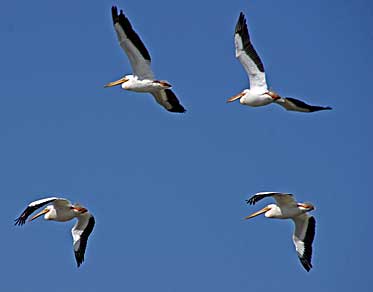
 |
|
|
|
New report shows birds in decline
June 2009 A new report released by Secretary of the Interior Ken Salazar shows that nearly a third of the nation’s 800 bird species are in trouble due to habitat loss, invasive species, and other threats. The report, The U.S. State of the Birds, synthesizes data from three long-running bird censuses conducted by thousands of citizen scientists and professional biologists.  Wetlands management and restoration have contributed to thriving populations of American White Pelican. Photo by Erica Crawford Birds in trouble include not only the California Condor and the Marbled Murrelet, but other local favorites such as the Snowy Plover, Solitary Sandpiper, Chestnut-backed Chickadee, and Pine Siskin. At the same time, the report highlights examples, including many species of waterfowl, where habitat restoration and conservation have reversed previous declines, offering hope that it is not too late to take action to save declining populations. “Just as they were when Rachel Carson published Silent Spring nearly 50 years ago, birds today are a bellwether of the health of land, water, and ecosystems,” Salazar said. “From shorebirds in New England to warblers in Michigan, we are seeing disturbing downward population trends that should set off environmental alarm bells. We must work together now to ensure we never hear the deafening silence in our forests, fields, and backyards that Rachel Carson warned us about.” The report calls attention to the crisis in Hawaii, where more birds are in danger of extinction than anywhere else in the United States. In addition, the report indicates a 40% decline in grassland birds over the past 40 years, a 30% decline in birds of aridlands, and high concern for many coastal shorebirds. Furthermore, 39% of species dependent on oceans have declined. However, the report also reveals convincing evidence that birds can respond positively to conservation action. The data show dramatic increases in many wetland birds such as pelicans, herons, egrets, osprey, and ducks, a testament to numerous cooperative conservation partnerships that have resulted in protection, enhancement, and management of more than 30 million wetland acres. Surveys conducted by the U.S. Fish and Wildlife Service and U.S. Geological Survey, combined with data gathered through volunteer citizen science programs such as the National Audubon Society’s Christmas Bird Count, show once abundant birds such as the marbled murrelet are declining significantly. The possibility of extinction remains a cold reality for many endangered birds. Birds are beautiful, as well as economically important and a priceless part of America’s natural heritage. Birds are also highly sensitive to environmental pollution and climate change, making them critical indicators of the health of the environment on which we all depend. The U.S. Fish and Wildlife Service coordinated creation of the new report as part of the U.S. North American Bird Conservation Initiative, which includes partners from American Bird Conservancy, the Association of Fish and Wildlife Agencies, Cornell Lab of Ornithology, Klamath Bird Observatory, National Audubon Society, The Nature Conservancy, and the U.S. Geological Survey. To view the full report with its beautiful photos visit www.stateofthebirds.org. |
|